splash
Papers released in the first LtU splash on Feb 18, 2025.
2025
-
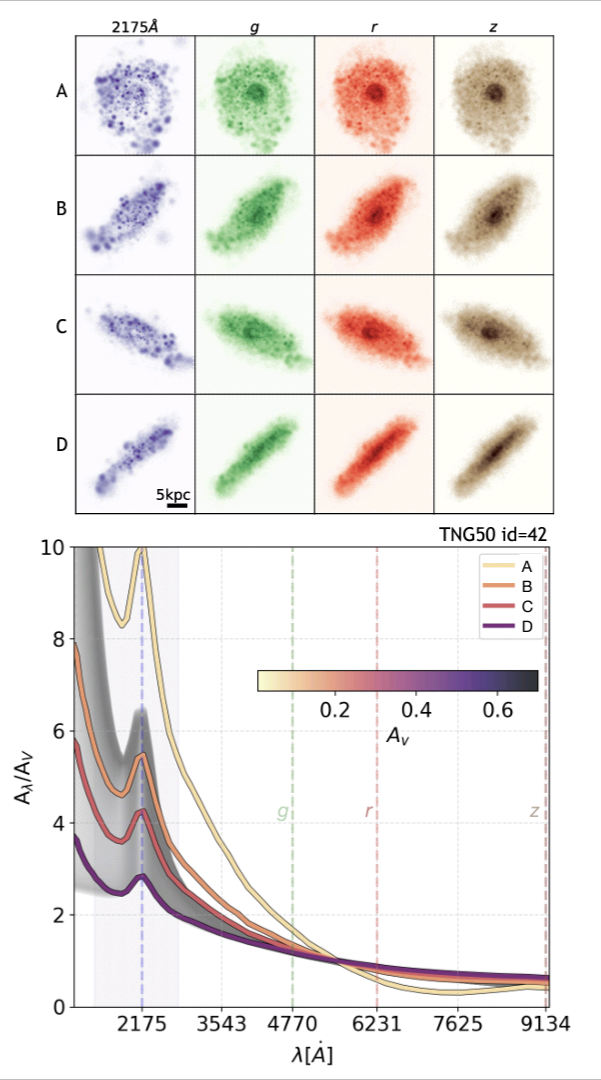 Learning the Universe: physically-motivated priors for dust attenuation curvesLaura Sommovigo, Rachel K. Cochrane, Rachel S. Somerville , and 9 more authors2025
Learning the Universe: physically-motivated priors for dust attenuation curvesLaura Sommovigo, Rachel K. Cochrane, Rachel S. Somerville , and 9 more authors2025We analyze the dust attenuation curves of ∼6400 galaxies from the IllustrisTNG50 & TNG100 simulations, considering 51 lines of sight per galaxy in the radiative transfer post-processing. We fit the curves with a versatile parametric model that reproduces various known extinction and attenuation curves. We identify strong correlations between attenuation curve parameters and intrinsic galaxy properties, enabling predictions of median dust attenuation curves based on \Sigma_\rm SFR and/or A_V, which align well with observational data. The resulting PDFs and scaling relations can be used as priors in inference studies, such as those conducted within the Learning the Universe (LtU) project, and for SED fitting applications.
@article{Sommovigo2025, title = {Learning the Universe: physically-motivated priors for dust attenuation curves}, author = {Sommovigo, Laura and Cochrane, Rachel K. and Somerville, Rachel S. and Hayward, Christopher C. and Lovell, Christopher C. and Starkenburg, Tjitske and Popping, Gergö and Iyer, Kartheik and Gabrielpillai, Austen and Ho, Matthew and Steinwandel, Ulrich P. and Perez, Lucia A.}, year = {2025}, eprint = {2502.13240}, archiveprefix = {arXiv}, primaryclass = {astro-ph.GA}, url = {https://arxiv.org/abs/2502.13244}, } -
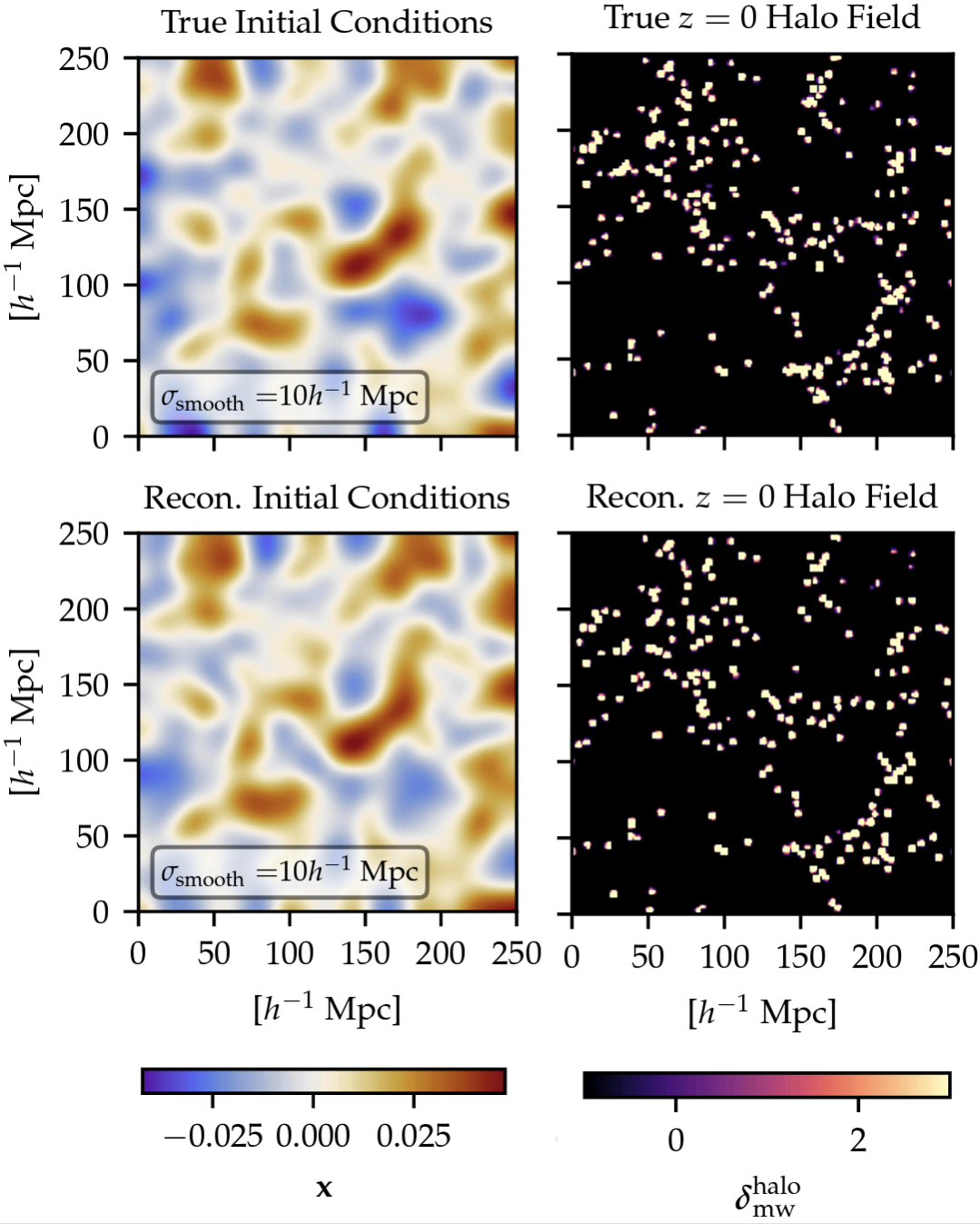 Learning the Universe: Learning to Optimize Cosmic Initial Conditions with Non-Differentiable Structure Formation ModelsLudvig Doeser, Metin Ata, and Jens Jasche2025
Learning the Universe: Learning to Optimize Cosmic Initial Conditions with Non-Differentiable Structure Formation ModelsLudvig Doeser, Metin Ata, and Jens Jasche2025We introduce Learning the Universe by Learning to Optimize (LULO), a novel framework for reconstructing 3D cosmic initial conditions by fitting state-of-the-art non-differentiable simulators to cosmological data. By leveraging deep learning as an optimizer while keeping full physics simulations in the loop, LULO can accurately recover late-time structures in the non-linear regime, thus providing a promising path forward for non-linear field-level inference without requiring a differentiable physics model.
@article{Doeser2025, title = {Learning the Universe: Learning to Optimize Cosmic Initial Conditions with Non-Differentiable Structure Formation Models}, author = {Doeser, Ludvig and Ata, Metin and Jasche, Jens}, year = {2025}, eprint = {2502.13243}, archiveprefix = {arXiv}, primaryclass = {astro-ph.CO}, url = {https://arxiv.org/abs/2502.13244}, } -
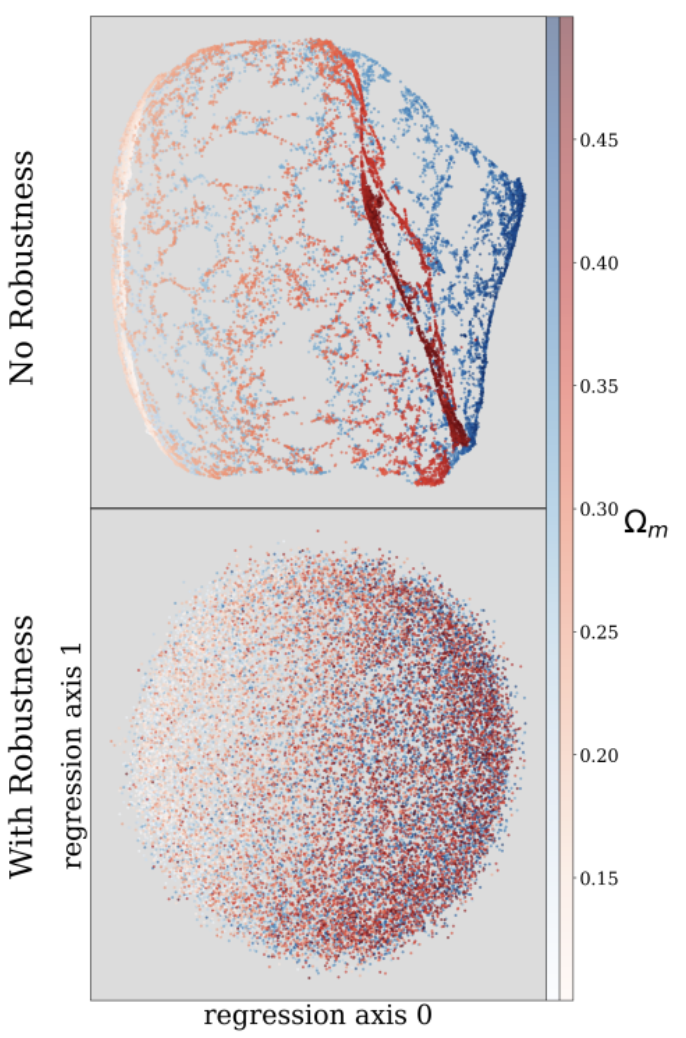 Towards Robustness Across Cosmological Simulation Models TNG, SIMBA, ASTRID, and EAGLEYongseok Jo, Shy Genel, Anirvan Sengupta , and 3 more authors2025
Towards Robustness Across Cosmological Simulation Models TNG, SIMBA, ASTRID, and EAGLEYongseok Jo, Shy Genel, Anirvan Sengupta , and 3 more authors2025We develop the Model-Insensitive Estimator (Miest), a machine learning framework that robustly estimates the cosmological parameters Ωm and σ8 from neutral hydrogen maps across multiple simulation models in the CAMELS project. By extracting only common features and disregarding model-specific variations, Miest improves predictive performance on unseen simulations by ∼17% for Ωm and 38% for σ8, enabling more reliable cosmological inference.
@article{Jo2025, title = {Towards Robustness Across Cosmological Simulation Models TNG, SIMBA, ASTRID, and EAGLE}, author = {Jo, Yongseok and Genel, Shy and Sengupta, Anirvan and Wandelt, Benjamin and Somerville, Rachel and Villaescusa-Navarro, Francisco}, year = {2025}, eprint = {2502.13239}, archiveprefix = {arXiv}, primaryclass = {astro-ph.CO}, url = {https://arxiv.org/abs/2502.13244}, } -
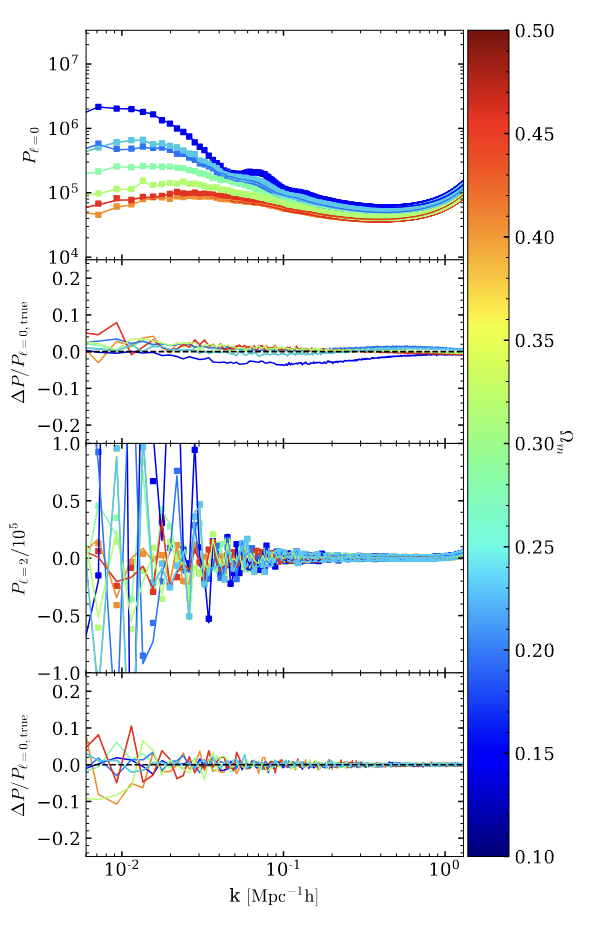 Learning the Universe: 3 h^-1\rm Gpc Tests of a Field Level N-body Simulation EmulatorMatthew T. Scoggins, Matthew Ho, Francisco Villaescusa-Navarro , and 3 more authors2025
Learning the Universe: 3 h^-1\rm Gpc Tests of a Field Level N-body Simulation EmulatorMatthew T. Scoggins, Matthew Ho, Francisco Villaescusa-Navarro , and 3 more authors2025We test a field-level emulator for non-linear cosmic structure formation at (3 h\(^-1\)Gpc)\(^3\)volumes by comparing its outputs to N-body simulations across eight cosmologies. The emulator accurately reproduces key summary statistics, including power spectra and bispectra, while achieving a thousandfold speedup over traditional N-body simulations, making it a valuable tool for large-scale cosmological inference.
@article{Scoggins2025, title = {Learning the Universe: $3\ h^{-1}{\rm Gpc}$ Tests of a Field Level $N$-body Simulation Emulator}, author = {Scoggins, Matthew T. and Ho, Matthew and Villaescusa-Navarro, Francisco and Jamieson, Drew and Doeser, Ludvig and Bryan, Greg L.}, year = {2025}, eprint = {2502.13242}, archiveprefix = {arXiv}, primaryclass = {astro-ph.CO}, url = {https://arxiv.org/abs/2502.13244}, } -
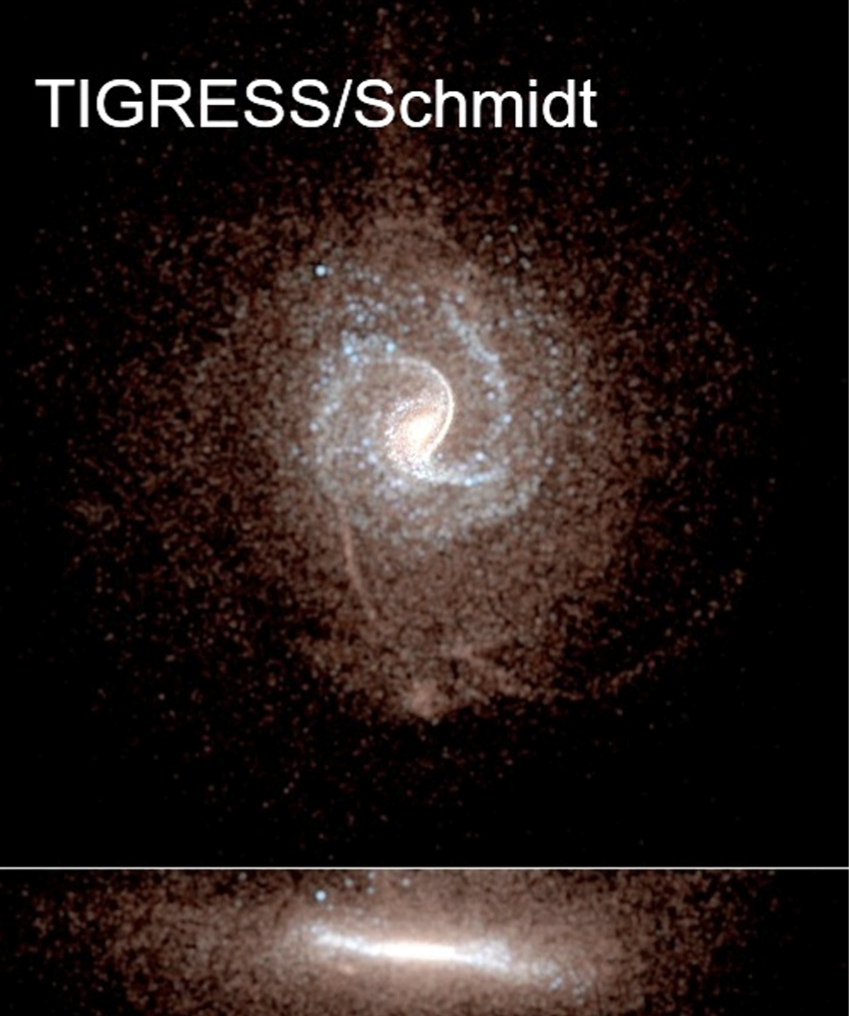 Applying a star formation model calibrated on high-resolution interstellar medium simulations to cosmological simulations of galaxy formationJan D. Burger, Volker Springel, Eve C. Ostriker , and 11 more authors2025
Applying a star formation model calibrated on high-resolution interstellar medium simulations to cosmological simulations of galaxy formationJan D. Burger, Volker Springel, Eve C. Ostriker , and 11 more authors2025This paper develops a realization of an effective equation model for regulating star formation in cosmological simulations, based on the pressure-regulated, feedback-modulated theory of star formation which is in turn calibrated on high-resolution small-scale simulations of the interstellar medium. We then test and compare this to the heuristic IllustrisTNG and SH models, using isolated galaxies and cosmological zoom simulations. In passing, we also introduce a new "multi zoom-in" initial conditions code.
@article{Burger2025, title = {Applying a star formation model calibrated on high-resolution interstellar medium simulations to cosmological simulations of galaxy formation}, author = {Burger, Jan D. and Springel, Volker and Ostriker, Eve C. and Kim, Chang-Goo and Jeffreson, Sarah M. R. and Smith, Matthew C. and Pakmor, Rüdiger and Hassan, Sultan and Fielding, Drummond and Hernquist, Lars and Bryan, Greg L. and Somerville, Rachel S. and Bennett, Jake S. and Weinberger, Rainer}, year = {2025}, eprint = {2502.13244}, archiveprefix = {arXiv}, primaryclass = {astro-ph.GA}, url = {https://arxiv.org/abs/2502.13244}, } -
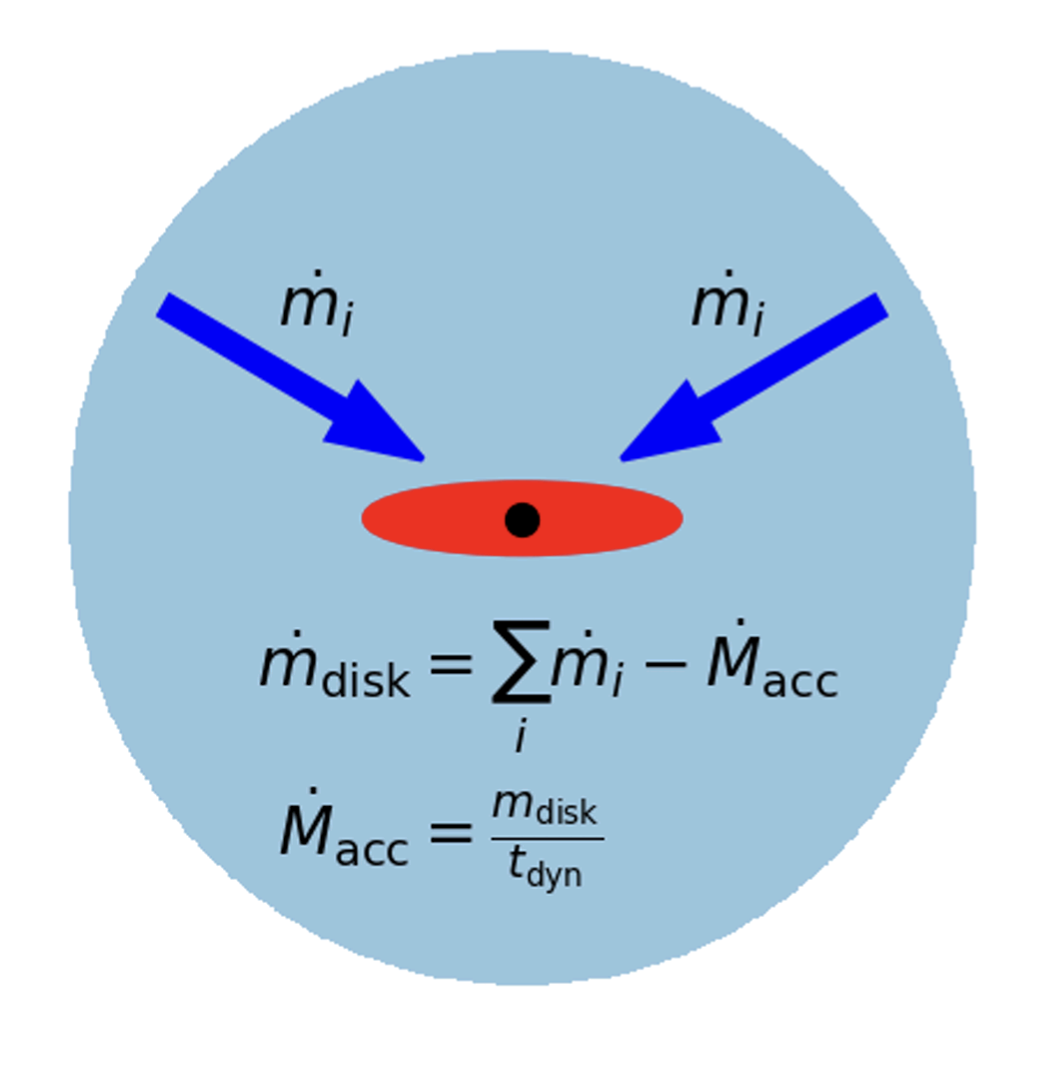 Accretion onto supermassive and intermediate mass black holes in cosmological simulationsRainer Weinberger, Aklant Bhowmick, Laura Blecha , and 5 more authors2025
Accretion onto supermassive and intermediate mass black holes in cosmological simulationsRainer Weinberger, Aklant Bhowmick, Laura Blecha , and 5 more authors2025A new, flexible parameterization of gas accretion onto massive black holes is introduced. Using cosmologial simulations with varying parameters, the impact of accretion microphysics onto the massive black hole population and possible observable signatures is studied.
@article{Weinberger2025, title = {Accretion onto supermassive and intermediate mass black holes in cosmological simulations}, author = {Weinberger, Rainer and Bhowmick, Aklant and Blecha, Laura and Bryan, Greg and Buchner, Johannes and Hernquist, Lars and Hlavacek-Larrondo, Julie and Springel, Volker}, year = {2025}, eprint = {2502.13241}, archiveprefix = {arXiv}, primaryclass = {astro-ph.GA}, url = {https://arxiv.org/abs/2502.13244}, }